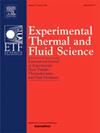Experimental investigation on the behavior and heat transfer of droplet impacting on heated surface
IF 3.3
2区 工程技术
Q2 ENGINEERING, MECHANICAL
Experimental Thermal and Fluid Science
Pub Date : 2025-06-18
DOI:10.1016/j.expthermflusci.2025.111549
引用次数: 0
Abstract
Water droplet impact onto a heated hydrophilic sapphire, with surface temperature from 100 to 600 °C, was visualized with synchronized bottom- and side-view high-speed cameras. The liquid–solid contact modes are defined based on the morphology in the bottom-view images. Four types of dynamic contact patterns, i.e., mottled, finger, ring and dot contact patterns, are identified. Synthesizing the side- and bottom-view images, droplet impact behaviors are classified into four regimes: deposition, rebound after contact, breakup after contact and Leidenfrost. The ring contact pattern, appearing at ≈300°C, entraps generated vapor and results in upward jetting. The bottom-view images are processed and analyzed to quantify the liquid–solid contact area in each frame. Based on the solution of one-dimensional transient heat conduction within the contact area, heat transfer resulted from instantaneous liquid–solid contact was estimated. The total amount of heat transfer (Q) resulted from single droplet impact decreases with increasing surface temperature (). However, on the Q- curves the inflection points are observed near 300°C, implying heat transfer enhancement accompanied by upward jetting.
液滴撞击受热表面的行为与传热实验研究
通过同步的底部和侧面高速摄像机,可以看到水滴撞击表面温度为100至600°C的加热亲水蓝宝石。根据底视图图像中的形貌定义了液固接触模式。确定了四种类型的动态接触模式,即斑驳、手指、环和点接触模式。综合侧面和底部图像,将液滴的撞击行为分为四种状态:沉积、接触后反弹、接触后破碎和莱顿弗勒斯特。在Tw≈300°C时出现的环状接触模式捕获了生成的蒸汽并导致向上喷射。对底视图图像进行处理和分析,以量化每帧中的液固接触面积。在求解接触区域内一维瞬态热传导的基础上,估计了液固瞬时接触产生的传热。单液滴撞击产生的总换热量Q随着表面温度Tw的升高而减小。然而,在Q-Tw曲线上,在300°C附近观察到拐点,这意味着传热增强伴随着向上喷射。
本文章由计算机程序翻译,如有差异,请以英文原文为准。
求助全文
约1分钟内获得全文
求助全文
来源期刊

Experimental Thermal and Fluid Science
工程技术-工程:机械
CiteScore
6.70
自引率
3.10%
发文量
159
审稿时长
34 days
期刊介绍:
Experimental Thermal and Fluid Science provides a forum for research emphasizing experimental work that enhances fundamental understanding of heat transfer, thermodynamics, and fluid mechanics. In addition to the principal areas of research, the journal covers research results in related fields, including combined heat and mass transfer, flows with phase transition, micro- and nano-scale systems, multiphase flow, combustion, radiative transfer, porous media, cryogenics, turbulence, and novel experimental techniques.
 求助内容:
求助内容: 应助结果提醒方式:
应助结果提醒方式:


